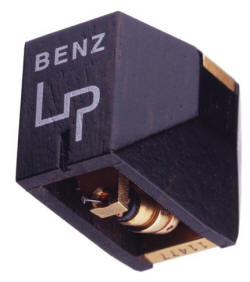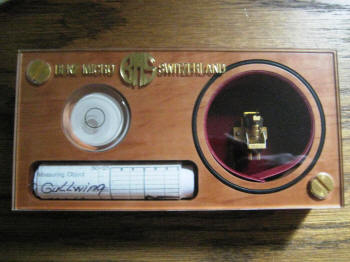Time marches slowly in the world of high-end audio. We rarely see new products that can be called “revolutionary”. While there are certainly new ideas, new materials, and new circuits developed by creative audio engineers, the vast majority of products are updates and refinements to previously released components. We have two of these under review here.
Benz-Micro has a long history in the cartridge business. In the 1970s, it supplied diamond styli to other manufacturers. Soon after, they introduced their own models which quickly grew into a complete product line covering both moving magnet and moving coil models in a wide range of output voltages and a wider range of prices. Along with such other manufacturers as Miyajima, Ortofon, Koetsu, Lyra, ZYX, and others, Benz cartridges are some of the most wanted cartridges in today’s marketplace.

The predecessor to the Benz LP-S, called the Benz LP, was reviewed here on 10 Audio in 2008. At that time, the cartridge, mounted on a Tri-Planar tonearm, received a 10 LP rating. The Benz LP had a signature or characteristic sound, which was summarized in the review with the comment that “a bit more sparkle and life in the upper treble might be a welcome thing”. As you can read in the review, this did not keep it from being a very musical phono cartridge, but as with any component with a noticeable sonic character, it definitely made system matching a requirement. This is to assure synergy with other system components for the overall result to be similar from any installed source.
The review system included, at various times, a SOTA Cosmos Vacuum table with Tri-Planar VII u2 tonearm, Amazon Referenz Turntable and MØRCH DP-8 tonearm, SOTA Satellite Turntable and Origin Live Zephyr tonearm, and a Basis 2500 Signature table with Vector 4 tonearm. Phono preamps included a Rogue Ares, Mark Levinson No. 326S with phono, Prism Orpheus used with a Bob’s Devices 1130 step up transformer, Whest PS.30RDT Special Edition, Lamm LP2, Fosgate Signature, and a Sutherland 20/20.
The Benz LP-S, $5,000, is indeed an evolutionary step up from the Benz LP. The LP-S is simply a higher resolution device. It looks identical to the older LP and a check with the included test report, listing model and serial number, was needed to confirm that the cartridge was actually the newer LP-S. The cartridge’s weight of 16 grams should be approved by your tonearm maker to confirm that this heavyweight can be installed properly. The increased resolution is apparent across the board, from the lowest bass to the upper treble. The improvement is most apparent in the mid-to-upper midrange, with smaller – sometimes much smaller – increases in the lower bass and upper treble. Where the LP-S most displayed an improvement worthy of a new model name was in it sound stage presentation. The LP-S seems to offer a more 3-dimensional and believable presentation.
I say “seems” because my system is almost completely different than the one employed for the LP review over 5 years ago. However, as each change was installed, it was very apparent how that change affected the overall sound. Certainly, noting this continuum of changes is nowhere near as reliable as a direct A-B comparison of two components. Even so, I am reasonably and reliably confident that the LP-S is, indeed, a better performer than the previous model.
I am very confident in repeating the conclusion from the LP review: A bit more sparkle and life in the upper treble would be a welcome thing. This is not a matter of quality, because the overall level at which the LP-S performs allows it to compete at the highest levels. But, in the context of the current review system, it was clear that this was still a valid, maybe even more so, reaction to the LP-S’s presentation. If your system is on the warm or mellow or “polite” side, and not forward, aggressive, or bright, then the LP-S would probably not be a good match.

The Benz Gullwing SLR, $3000, has a specified output of 0.35mV. The balanced overall sound benefits greatly from full break in of about 100-120 hours. The bass is not as powerful as the LP-S, but to its credit, the Gullwing’s treble is more extended and airy: more neutral. Or it is more forward, depending on your point of view.
The Gullwing has excellent detail and resolution, and organ and piano, for example, have good harmonic consistency from octave to octave. This ability to present fine detail is apparent during complex music as each instrument line is clear and distinct, never becoming confused or congested. An orchestra’s string section is well defined with apparent layering of rows of performers. Cymbals ring like real metal does and the harmonic trail lasts a long time as it fades into silence. Resolution never seems to be an issue even though other cartridges can dig a little bit deeper into the microvolt-level details that make vinyl playback so enjoyable.
The sense of left to right instrument placement on the virtual sound stage is excellent, while the overall depth of the stage, not to mention the deepest or farthest areas, is clearly bettered by the LP-S. Musicians are quite two-dimensional instead of the more believable presentation of the LP-S.
The upper midrange and lower treble, which is the range where many components have various problems, is excellent. If this frequency range is forward or otherwise not balanced correctly with the midrange and treble then it can be perceived as glare or forwardness. Fortunately, the Gullwing avoids this imbalanced tonal quality, although there is a degree of harshness and a coarse quality in the lower treble. The vocal presentation of the Gullwing is easily its strength. Both male and female singers are very realistic and present. In fact, in the midrange, the Gullwing can hold its own in the company of far more expensive products.
The bass is also excellent. The Gullwing offers tuneful bass that strikes an excellent balance between richness and resolution: never too fat or slow and never lean or threadbare. It is always easy to follow a bass line or hear the difference between different instruments, whether string or percussion, playing the lower register.
The loading effects of the phono preamp can have a noticeable impact on both tonal balance and dynamics. Even with optimal loading, which varied according to which phono stage was in play, dynamics were somewhat muted reducing the overall sense of scale and the power of a climax. The micro or low level dynamic character is excellent giving the Gullwing the ability to easily differentiate subtle changes in a musician’s technique.

Experimentation with loading will pay huge dividends in the final sound. We often apply a simple “times 20” rule for resistive loading for moving coil cartridges. With the Gullwing’s 38 Ohm DC resistance, this implies loading at around 750 Ohms. As the resistance increases above about 400 Ohms resistive or 200 Ohms with a step up transformer, the sound really opens up with greater sparkle and air. Even with a loading at 47,000 Ohms (or 1 Meg Ohm straight into the Prism Orpheus instrument inputs), excessive ringing, which is easily heard as harsh sibilants and splashy cymbals, is minimal with the Gullwing. The best advice for loading modern cartridges is to keep increasing the loading value until a sense of harshness enters the aural picture. Higher value loading improves dynamics and bass resolution; too high a value and treble purity is harmed.
The Gullwing is harmonically richer, especially in the upper frequencies, than the Lyra Helikon SL, and is similar in many ways to the Shelter 901. The Miyajima Shilabe performs at a higher level for about the same price. The SLR is very easy to install on a tonearm and set up correctly due to the protruding stylus. I used both a Denneson Soundtracktor and a van den Hul mirrored alignment gauge and both produced excellent results.
The Gullwing SLR has a sound character that grows on you over time, although that change in acceptance could also work against a long term relationship. The Gullwing is more naturally extended in the treble than a Koetsu Urushi with much tighter, more realistic bass. Listening to record after record, and often finding enjoyment, the Benz Gullwing SLR could provide hours of musical enjoyment for many happy owners.
Overall Ratings:
LP-S: 10 LPs
SLR Gullwing: 8 LPs
